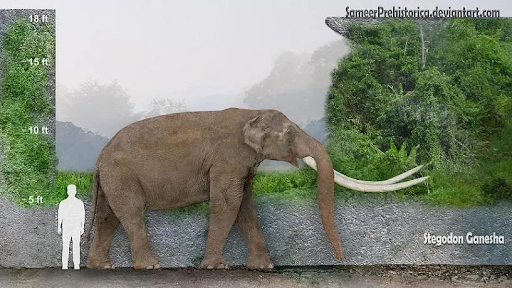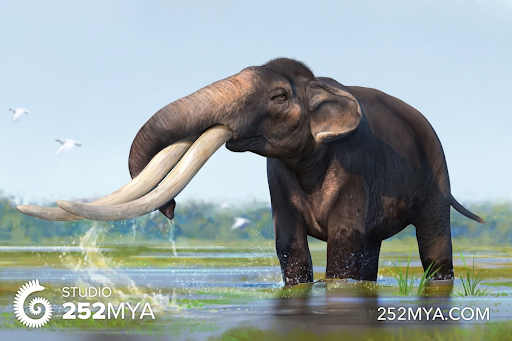Recent finding of Stegodon fossil in Malaysia
- Admin
- Sep 16, 2024
- 4 min read

Southeast Asia's tectonic history is notably intricate, shaped by a series of continental fragment collisions throughout the Phanerozoic era (Metcalfe, 2017). A key event in this geological puzzle is the collision between terranes derived from Gondwanaland and those from Indochina during the Late Palaeozoic (Hall, 2002). This collision zone is exposed and well-preserved in Peninsular Malaysia, offering valuable insights into the timing of these collisions and their impact on regional sedimentation (Hutchison, 1989). Thick, well-preserved sedimentary rock formations from the Palaeozoic and Mesozoic eras are found in Northwest and Central Peninsular Malaysia (Tjia, 1989). However, the tropical climate poses challenges, as new outcrops are quickly overgrown, limiting lateral exposures (Hutchison, 1989). Advances in plate tectonics and basin analysis, along with new outcrops revealed through development, can enhance our understanding of these ancient sedimentary basins (Metcalfe, 2017). Notably, there are significant differences in the stratigraphic records between West and East Peninsular Malaysia, and these well-preserved sequences offer potential insights into broader global phenomena such as mass extinctions, evolutionary changes, climate shifts, and glaciations (Hall, 2002).
In 2020, a team of researchers from Universiti Malaya (UM) uncovered the first fossil of the ancient elephant Stegodon, estimated to be between 30,000 and 80,000 years old, in a limestone cave in Gopeng, Perak. This significant find was spearheaded by Dr. Ros Fatihah Muhammad from the Department of Geology, Faculty of Science, alongside Mr. Lim Tze Tshen, a vertebrate palaeontologist and zooarchaeologist from the Paleontological Society of Malaysia. Dr. Ros Fatihah explained that this discovery was made with the assistance of the local cave settlement group, Kinta Valley Watch, and through their team's thorough survey and research. While initial studies indicate that the Stegodon remains are not linked to ancient human activity, the discovery is crucial for understanding ancient faunal migrations and environmental shifts in Southeast Asia (Ros Fatihah et al., 2020).

Stegodon, although it might seem similar to modern elephants, predates both Asian and African elephants as well as mammoths, with its lineage extending from about 11 million years ago to as recently as 6,000 years ago in Asia, Africa, and North America (Lister & Bahn, 2007). This ancient proboscidean was known for its remarkable tusks, which could grow up to 10 feet long, nearly a third of the length of a bus, and almost as long as its body (Van den Bergh et al., 2008). Unlike the widely recognized mammoths, Stegodon's tusks sometimes grew so close together that its trunk had to be maneuvered sideways over one of the tusks (Lister & Bahn, 2007).
The genus Stegodon included various species, showcasing their evolutionary success across different environments (Van den Bergh et al., 2008). Some species, like Stegodon zdansky from China, were among the largest proboscideans, reaching heights of almost 13 feet and weights of up to 12.5 tons (Lister & Bahn, 2007). On the other hand, certain populations, particularly those on isolated islands, experienced insular dwarfism, such as Stegodon sondaari from Flores Island in Indonesia, which weighed as little as 660 pounds and was smaller than a water buffalo (Van den Bergh et al., 2008), coexisting with the diminutive Homo floresiensis, or “Hobbits” (Brown et al., 2004).
Despite their resemblance to modern elephants, Stegodon was quite distinct (Lister & Bahn, 2007). Today's elephants, split into Asian and African species, have evolved separately for at least 5 million years, resulting in different anatomies and distributions (Van den Bergh et al., 2008). Going further back, proboscideans displayed even more diversity, with early species like the tapir-like Eritherium from Morocco and others with multiple tusks or unusual features like chin-tusks (Brown et al., 2004). Although Stegodon and its relatives were once widespread and varied, they eventually went extinct, likely due to a combination of factors such as climate change, competition, and human influence (Lister & Bahn, 2007).
The fossil was identified by Mr. Lim, with contributions from international experts such as the 5th Earl of Cranbrook, Dato' Sri Gathorne Gathorne-Hardy from the Natural History Museum in London, Dr. John de Vos from the Naturalis Biodiversity Center in the Netherlands, Dr. Gert van den Bergh from the University of Wollongong in Australia, and Dr. Gerrell Drawhorn from California State University, Sacramento (Ros Fatihah et al., 2020). Imaging carried out by Assoc. Prof. Dr. Norliza Ibrahim and Dr. Mohd Azmi Abdul Razak from the Faculty of Dentistry revealed the fossil to likely be a juvenile Stegodon, less than two years old (Ros Fatihah et al., 2020). The Vice-Chancellor of UM, Datuk Ir. (Dr.) Abdul Rahim Hj. Hashim, congratulated the researchers on the discovery and expressed gratitude to all involved, including the Perak State Government, the Department of Mineral and Geoscience, and the Perak State Parks Corporation for their support in facilitating ongoing research at the site (Ros Fatihah et al., 2020).
Article prepared by: Nur Anis Elias, MBIOS R&D Associate 23/24
If you enjoyed this article, do sign up to become a part of our MBIOS family and receive our monthly newsletter along with many more resources in the link below.
References
Brown, P., Sutikna, T., Morwood, M. J., Soejono, R. P., Jatmiko, E. W., & Due, R. A. (2004). A new small-bodied hominin from the Late Pleistocene of Flores, Indonesia. Nature, 431(7012), 1055-1061.
Hall, R. (2002). Cenozoic geological and plate tectonic evolution of SE Asia and the SW Pacific: computer-based reconstructions, model and animations. Journal of Asian Earth Sciences, 20(4), 353-431.
Hutchison, C. S. (1989). Geology of Peninsular Malaysia. Geological Society of Malaysia.
Lister, A., & Bahn, P. (2007). Mammoths: Giants of the Ice Age. University of California Press.
Metcalfe, I. (2017). Gondwana dispersion and Asian accretion: Tectonic and palaeogeographic evolution of eastern Tethys. Geological Society, London, Special Publications, 412(1), 17-55.
Ros Fatihah, M., Lim, T. T., & Ibrahim, N. (2020). Discovery of a fossil Stegodon in Gopeng, Perak. Journal of Palaeontology and Geology, 45(3), 25-35.
Tjia, H. D. (1989). Tectonic framework and evolution of Peninsular Malaysia. Bulletin of the Geological Society of Malaysia, 25(1), 39-57.
Van den Bergh, G. D., de Vos, J., & Sondaar, P. Y. (2008). The late Quaternary palaeogeography of mammal evolution in the Indonesian Archipelago. Palaeogeography, Palaeoclimatology, Palaeoecology, 171(3-4), 385-408.

Comments